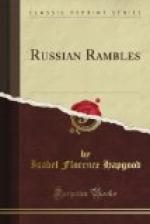But we must return to the Nevsky Prospekt. Nestling at the foot of the City Hall, at the entrance of the broad street between it and the Gostinny Dvor, on the Nevsky, stands a tiny chapel, which is as thriving as the bazaar, in its own way, and as striking a compendium of some features in Russian architecture and life. Outside hangs a large image of the “Saviour-not-made-with-hands,”—the Russian name for the sacred imprint on St. Veronica’s handkerchief,—which is the most popular of all the representations of Christ in ikoni. Before it burns the usual “unquenchable lamp,” filled with the obligatory pure olive-oil. Beneath it stands a table bearing a large bowl of consecrated water. On hot summer days the thirsty wayfarer takes a sip, using the ancient Russian kovsh, or short-handled ladle, which lies beside it, crosses himself, and drops a small offering on the dish piled with copper coins near by, making change for himself if he has not the exact sum which he wishes to give.
Inside, many ikoni decorate the walls. The pale flames of their shrine-lamps are supplemented by masses of candles in the huge standing candlesticks of silver. A black-robed monk from the monastery is engaged, almost without cessation, in intoning prayers of various sorts, before one or another of the images. The little chapel is thronged; there is barely room for respectfully flourished crosses, such as the peasant loves, often only for the more circumscribed sign current among the upper classes, and none at all for the favorite “ground reverences.” The approach to the door is lined with two files of monks and nuns: monks in high klobuki, like rimless chimney-pot hats, draped with black woolen veils, which are always becoming; tchernitzi, or lay sisters, from distant convents, in similar headgear, in caps flat or pointed like the small end of a watermelon, and with ears protected by black woolen shawls ungracefully pinned. Serviceable man’s boots do more than peep out from beneath the short, rusty-black skirts. Each monk and nun holds a small pad of threadbare black velvet, whereon a cross of tarnished gold braid, and a stray copper or two, by way of bait, explain the eleemosynary significance of the bearers’ “broad” crosses, dizzy “reverences to the girdle,” and muttered entreaty, of which we catch only: “Khristi Radi”—For Christ’s sake.




